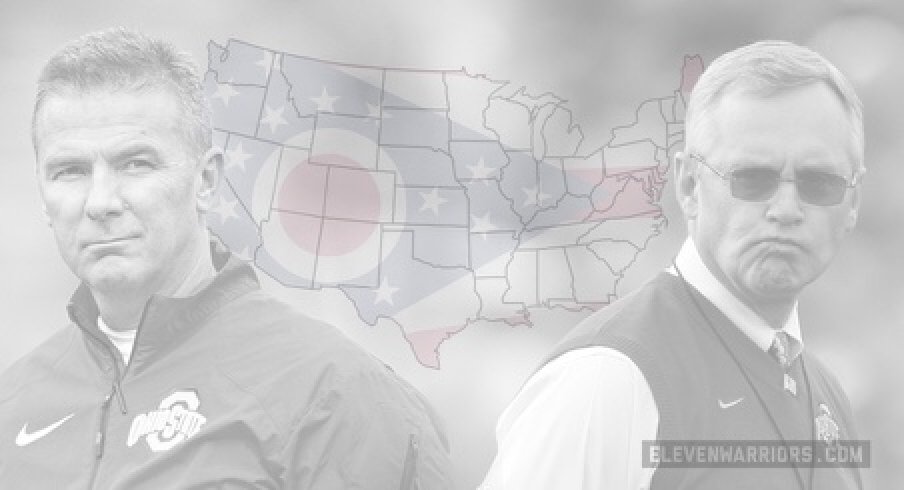The last four seasons could arguably be considered the golden era of Ohio State football. The Buckeyes posted a 50-4 overall record with a 31-1 regular season Big Ten mark; captured one national championship and one Big Ten title and played in three consecutive New Year's Day bowl games. If it weren't for two unspeakable upsets at the hands of Michigan State late in the 2013 and 2015 seasons, head coach Urban Meyer could have even more hardware in his trophy case.
Things weren't so bad under former head coach Jim Tressel, either. The Senator, as he was affectionately known, won 106 games and lost only 22; secured the program's first national title in 32 years; racked up seven Big Ten championships; and played in eight Bowl Championship Series games. If not for two title game defeats — one at the hands of the aforementioned Meyer — Tressel might just be mentioned in the same breath at legendary coach Woody Hayes.
Quite simply, the last 15 years of Ohio State football (save for the disastrous 2011 season) are unprecedented. Each coach's resounding successes can be attributed to a number of different factors, be it the culture they've created in Columbus or their belief that punting is the most important play in football.
One thing that differs, however, is Meyer's willingness to recruit nationally, and his ability to reel those same prospects in. That's not to say that Tressel didn't try; he just didn't have as much success. For every out-of-state prospect like Pennsylvania's Terrelle Pryor the Buckeyes brought in, players like Minnesota's Seantrel Henderson, Pennsylvania's Shariff Floyd, West Virginia's Josh Jenkins and Virginia's Kyle Long looked the other way.
Tressel placed priority on in-state prospects, and very few of those he set his sights on spurned the Buckeyes. It was certainly an advantageous strategy, as high school football is deeply ingrained into the culture of Ohio, making it one of the most talent-rich states in the country.
That is, of course, behind the populous states of California, Florida, Georgia and Texas — all locations in which Meyer has increased Ohio State's presence in recent years. The fifth-year head coach has even said he will offer a scholarship to a prospect in another state earlier in the recruiting cycle than he would one in Ohio, which makes it less likely that any class will be comprised of a majority of local kids.
“Sometimes you have to offer a guy early [who is] out of state to get in the game,” Meyer said. “If you want to get in the game, sometimes you have to do that. I won't say it's positive or negative. But in-state, you've just got to be very cautious because when that offer goes out, you can't pull it. You're in it. Out of state, if you offer a guy, and he has a bunch of other offers, then you can just kind of move on. In Ohio, you have to be very careful.”
As oftentimes happened during the Tressel years, in-state players who grew up Ohio State fans would commit soon after receiving an offer. That's why several of his classes had two- and/or three-star prospects, whereas many would consider it a disappointment if Meyer were not hauling in pledges from four- and five-star athletes left and right.
With those expectations, Meyer's pursuit of the best players in the country resulted in fewer Ohians playing for the Buckeyes than ever before. And while this new era in recruiting may let a rival school steal a handful of underrated three-star prospects, it's how the Buckeyes must do things if they hope to maintain one of the country's premier college football programs.
Let's take an in-depth look at Ohio State's recruiting numbers by state under Meyer and Tressel:

| State |
Jim Tressel (2001-2011) 220 COMMITS* |
Urban Meyer (2012-2016) 137 Commits |
|---|---|---|
| Arkansas | N/A | 1 - 0.7 percent |
| California | 4 - 1.8 percent | 1 - 0.7 percent |
| Colorado | N/A | 1 - 0.7 percent |
| Florida | 22 - 10 percent | 11 - 8.1 percent |
| Georgia | 5 - 2.3 percent | 5 - 3.7 percent |
| Illinois | 4 - 1.8 percent | 5 - 3.7 percent |
| Indiana | 5 - 2.3 percent | 4 - 2.9 percent |
| Kansas | 1 - 0.5 percent | N/A |
| Kentucky | 2 - 0.9 percent | 2 - 1.5 percent |
| Louisiana | 1 - 0.5 percent | N/A |
| Maryland | 4 - 1.8 percent | 4 - 2.9 percent |
| Massachusetts | N/A | 2 - 1.5 percent |
| Michigan | 6 - 2.7 percent | 4 - 2.9 percent |
| Minnesota | 2 - 0.9 percent | 1 - 0.7 percent |
| Mississippi | N/A | 1 - 0.7 percent |
| Missouri | 1 - 0.5 percent | 2 - 1.5 percent |
| New Jersey | 2 - 0.9 percent | 5 - 3.7 percent |
| New York | 1 - 0.5 percent | 3 - 2.2 percent |
| North Carolina | 2 - 0.9 percent | 4 - 2.9 percent |
| Ohio | 135 - 61.4 percent | 66 - 48.5 percent |
| Pennsylvania |
14 - 6.4 percent |
2 - 1.5 percent |
| South Carolina | 1 - 0.5 percent | 1 - 0.7 percent |
| south dakota | N/A | 1 - 0.7 percent |
| Texas | 3 - 1.4 percent | 4 - 2.9 percent |
| Utah | N/A | 1 - 0.7 percent |
| Virginia | 3 - 1.4 percent | 6 - 4.4 percent |
| West Virginia | 1 - 0.5 percent | N/A |
*Ohio State signed Toronto, Canada, cornerback Michael Roberts in 2002.


